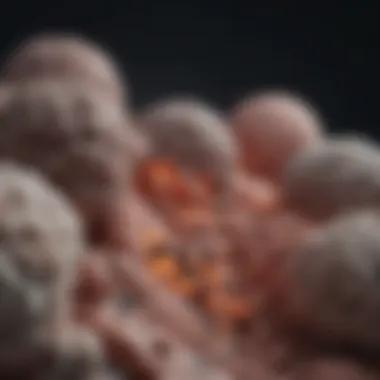Understanding Multiple GIST Tumors: A Deep Dive


Intro
Gastrointestinal stromal tumors, or GISTs, represent a unique category of tumors originating in the gastrointestinal tract. GISTs are pivotal in the spectrum of soft tissue sarcomas. This article aims to dissect multiple GIST tumors, revealing their anatomical, biological, and therapeutic dimensions. Understanding these tumors is crucial for healthcare professionals and researchers alike. The complexity surrounding their diagnosis, management, and treatment compels a thorough examination of the current knowledge and future directions in this field.
Key Findings
GISTs are primarily characterized by mutations in the KIT or PDGFRA genes, which lead to uncontrolled cellular growth. Some of the essential findings regarding multiple GIST tumors include:
- Diversity in Presentation: Multiple GISTs can manifest in various locations within the gastrointestinal tract, most commonly in the stomach and small intestine.
- Diagnostic Challenges: The identification of GISTs often requires advanced imaging techniques and biopsy, as they can mimic other tumor types.
- Treatment Approaches: Surgical resection remains the primary treatment for localized GISTs. For unresectable or metastatic cases, targeted therapies such as imatinib are commonly employed.
The significance of these findings within the scientific community cannot be overstated. They not only enhance clinical understanding but also highlight the need for ongoing research.
Implications of the Research
The insights gained from studying multiple GIST tumors lead to various applications in real-world scenarios:
- Patient Management: Enhanced diagnostic techniques and treatment protocols can result in better patient outcomes and tailored therapies.
- Future Research Directions: Understanding the molecular underpinnings can facilitate the development of novel therapies. Research trends are shifting towards investigating secondary mutations and the potential for resistance in treatment approaches.
"Understanding the biology of GISTs and their response to treatment is vital for advancing clinical practice and improving patient care."
Prologue to GISTs
Gastrointestinal stromal tumors, commonly referred to as GISTs, represent a unique category of tumors found predominantly in the digestive tract. The understanding of GISTs is vital for several reasons. First, they exhibit distinct biological and clinical characteristics that set them apart from other neoplasms in the gastrointestinal tract. Second, their management has evolved significantly with advancements in treatment options, particularly in the realm of targeted therapy. This section lays the groundwork for comprehending multiple GISTs and highlights the critical aspects necessary for effective diagnosis and treatment.
Definition of GISTs
GISTs are mesenchymal tumors arising from interstitial cells of Cajal or precursor cells. They are characterized by the expression of specific markers like CD117 (c-KIT) and CD34. These tumors can be found throughout the gastrointestinal tract but are most commonly seen in the stomach and small intestine. Their defining features allow for distinct pathophysiological and therapeutic considerations.
Incidence and Epidemiology
The incidence of GISTs is relatively low compared to other cancers, with an estimated occurrence of approximately 10-20 cases per million people annually. However, this statistic can be misleading due to underdiagnosis and the sporadic nature of these tumors. GISTs often affect adults, typically between the ages of 50 to 70. Studies show slightly higher prevalence in males than in females. Furthermore, certain genetic syndromes, such as neurofibromatosis type 1 and Carney triad, can increase the risk of developing these tumors.
"The rarity of GISTs does not diminish their clinical significance. These tumors demand attention due to their potential for aggressive behavior and distinct management protocols."
Histopathological Features
Histopathologically, GISTs display a range of cellular patterns. They can be spindle-shaped, epithelioid, or mixed. Tumor cells often exhibit a moderate degree of cytoplasm and variably sized nuclei. Additionally, a hallmark characteristic is the presence of the c-KIT mutation, which plays a significant role in tumor development and progression. Immunohistochemistry serves as a vital tool for diagnosis, with CD117 serving as the primary marker. Understanding these features is crucial for accurate classification and determining the appropriate treatment approach.
Multiple GISTs: An Overview
Gastrointestinal stromal tumors, or GISTs, present a unique set of challenges and considerations when they manifest as multiple tumors. This section aims to examine the dimensions of multiple GISTs, underscoring their significance within the broader context of these tumors. Understanding multiple GISTs is crucial for accurate diagnosis, effective treatment options, and optimal patient outcomes. The complexity introduced by simultaneous tumors can alter the approach of clinicians, necessitating a comprehensive awareness of their biological behavior and available management strategies.
Defining Multiple GISTs


Multiple GISTs refer to the presence of more than one gastrointestinal stromal tumor within a single individual. Unlike solitary GISTs, multiple tumors may indicate a distinct biological behavior and can result in varied clinical implications. These tumors can develop sporadically or be part of hereditary syndromes, complicating the understanding of their pathogenesis. Notably, hereditary GIST syndromes, like Carney-Stratakis syndrome and Neurofibromatosis type 1, are particularly linked with the development of multiple tumors in affected individuals. Accurately defining multiple GISTs enables a differentiation in treatment protocol, which is vital to patient care.
Pathophysiology of Multiple GISTs
The pathophysiology underlying multiple GISTs is complex, involving various genetic mutations and signaling pathways. The majority of GISTs arise from interstitial cells of Cajal or precursor cells, with the most frequent mutations occurring in the KIT or PDGFRA genes. In cases of multiple tumors, it is essential to consider the possibility of different mutation profiles existing within the same patient. Understanding these genetic variations is important for tailoring targeted therapies, which are designed to inhibit the specific pathways driving tumor growth. Furthermore, the immunological and microenvironmental factors influencing tumor genesis should not be overlooked, as they can contribute to the multifocal nature of GISTs.
Clinical Presentation
Clinically, multiple GISTs may present with a variety of symptoms depending on their size, location, and number. Patients often report nonspecific abdominal symptoms, which can lead to a delayed diagnosis. Commonly observed symptoms include abdominal pain, gastrointestinal bleeding, and intestinal obstruction. Moreover, the symptoms may be more pronounced with multiple tumors due to increased mass effect or inflammation of surrounding tissues. Early identification of these symptoms can be crucial for effective intervention, as the clinical management of multiple GISTs typically requires a multidisciplinary approach. Recognizing the signs of multiple GISTs, combined with a comprehensive evaluation of patient history, can significantly impact the diagnostic and treatment trajectories.
"The characteristics of multiple GISTs can lead to diagnostic challenges, necessitating a high index of suspicion among clinicians."
In summary, understanding multiple GISTs encompasses defining their nature, exploring the underlying pathophysiology, and recognizing their clinical manifestations. This knowledge forms the basis for effective management and treatment approaches that cater to the needs of patients affected by these tumors. Knowing the differences and complexities inherent in multiple GISTs is essential for both practitioners and researchers aiming for advancements in the field.
Diagnosis of Multiple GISTs
Diagnosing multiple gastrointestinal stromal tumors (GISTs) is critical in determining the best treatment options for patients. Early and accurate diagnosis can significantly improve outcomes and enhance the quality of care. Various diagnostic methods exist, each offering unique insights into the presence and characteristics of these tumors.
Imaging Techniques
Imaging techniques play a vital role in the diagnosis of multiple GISTs. They help visualize the tumors' locations, sizes, and potential metastases. Common imaging modalities include:
- Computed Tomography (CT) Scans: CT scans are particularly useful for identifying GISTs in the abdomen and pelvis. They provide detailed cross-sectional images that can reveal both primary tumors and any associated complications such as bleeding or obstruction.
- Magnetic Resonance Imaging (MRI): MRI can be advantageous in cases where patients cannot tolerate radiation. It is effective for soft tissue evaluation and can help differentiate GISTs from other types of tumors.
- Ultrasound: While less commonly used for GISTs specifically, ultrasound can assist in assessing tumors, especially in younger patients, due to the lack of ionizing radiation.
Overall, imaging techniques are crucial for evaluating the extent of disease, which informs treatment decisions.
Biopsy and Histological Examination
Biopsy is another essential component in the diagnosis of multiple GISTs. There are several ways to obtain tissue samples for histological examination:
- Endoscopic Ultrasound-Guided Fine Needle Aspiration (EUS-FNA): This method allows for precise sampling of gastrointestinal lesions and is beneficial for GISTs arising from the wall of the gastrointestinal tract.
- Percutaneous Needle Biopsy: For tumors that are accessible through the skin, percutaneous methods can be effective.
- Surgical Biopsy: In some cases, a surgical biopsy may be necessary to obtain enough tissue for a definitive diagnosis.
Histological examination facilitates the identification of the tumor's cellular characteristics. Most GISTs express CD117, which is crucial for confirming the diagnosis. Pathologists look for specific features, such as spindle cell morphology and a high mitotic index, to determine tumor aggressiveness.
Molecular Genetic Testing
Molecular genetic testing is a cutting-edge diagnostic tool with increasing importance in the evaluation of GISTs. Genetic analysis can identify mutations in the KIT or PDGFRA genes, which are commonly associated with these tumors. Understanding these mutations has several benefits:
- Personalized Treatment: Identifying specific mutations helps guide targeted therapy choices, such as Imatinib, which is effective for many GIST patients.
- Prognostic Value: Certain mutations can indicate tumor behavior, aiding in prognosis and treatment planning.
- Detection of Resistance: Molecular testing can also reveal if a tumor has developed resistance to specific therapies, facilitating timely shifts in treatment strategy.
For optimal management of multiple GISTs, combining imaging, histology, and molecular genetic testing creates a comprehensive diagnostic framework. This multifaceted approach not only enhances accuracy but also supports tailored treatment protocols.
Treatment Approaches for Multiple GISTs


Understanding effective treatment methods for multiple gastrointestinal stromal tumors (GISTs) is crucial for improving patient outcomes. Given the complexity of these tumors, a multifaceted approach to treatment is often necessary. The primary goals of treatment are to reduce tumor burden, manage symptoms, and improve the patient's quality of life. This section explores the key treatment modalities available for managing multiple GISTs, including surgical interventions, targeted therapies, and the role of radiation therapy.
Surgical Interventions
Surgery is often the first line of treatment for patients with localized multiple GISTs. The aim is to completely excise the tumors, which can lead to significant benefits in terms of disease management. Surgical interventions are typically supported by imaging techniques that assist in defining the extent of the disease.
- Indications for Surgery: Surgical interventions are most appropriate when the GISTs are resectable. Patients with limited metastatic disease may also benefit from surgical removal of the primary tumor.
- Types of Surgical Procedures: The common surgical procedures include wide resection or segmental removal of the affected organ. In cases where multiple tumors present, careful planning is essential to ensure optimal outcomes.
- Post-operative Care: Following surgery, patients require monitoring for recurrence or complications, which can occur even after successful resection. Regular follow-up appointments and imaging studies are necessary for ongoing assessment.
Targeted Therapy: Imatinib and Beyond
After the surgical approach, targeted therapy has emerged as a cornerstone in the management of GISTs, especially for unresectable or metastatic cases. Imatinib, a tyrosine kinase inhibitor, has revolutionized the treatment landscape for GISTs.
- Mechanism of Action: Imatinib works by inhibiting the activity of the mutated KIT and PDGFRA proteins that drive the growth of GIST tumors. This targeted mechanism results in a reduction of tumor size and mitigation of symptoms.
- Personalized Treatment: Treatment with Imatinib is often tailored to the individual based on mutational status. For instance, certain mutations are more responsive than others, impacting treatment outcomes significantly.
- Emerging Therapies: As resistance to Imatinib can occur, new therapies are being investigated. Options such as sunitinib and regorafenib have shown promise in patients who have not responded adequately to Imatinib. These agents offer alternative mechanisms of action and may be beneficial in overcoming resistance.
Radiation Therapy Considerations
While radiation therapy is not a primary treatment for GISTs, it can play a supportive role in specific scenarios. The uses and limitations of radiation therapy should be understood in the context of a comprehensive treatment plan.
- Palliative Use: In cases where GISTs cause significant local symptoms or complications, radiation therapy may be employed to alleviate pain or reduce tumor size. This is particularly pertinent in cases involving mass effect or nearby organ involvement.
- Adjuvant Therapy: Some studies suggest that radiation might have an adjunctive role after surgery, especially in high-risk cases, although this approach is still debated. Its effectiveness can vary depending on the individual patient and tumor characteristics.
- Lack of Efficacy for Primary Treatment: Research indicates that radiation therapy is not effective as a primary treatment modality for GISTs due to their resistant nature to ionizing radiation.
Prognosis and Outcomes
The prognosis and outcomes of multiple gastrointestinal stromal tumors (GISTs) are critical components in understanding the disease's progression and management. Prognosis refers to the likely course of the disease and the chance of recovery, while outcomes measure the effectiveness of various treatment modalities over time. Key factors in prognosis include tumor size, location, mitotic activity, and the presence of mutations in specific genes, particularly the KIT and PDGFRA genes.
Understanding prognosis allows clinicians to tailor treatment strategies effectively. Accurate prognostic assessment helps to predict the clinical course of the disease, informing both treatment decisions and patient management options.
Factors Influencing Prognosis
Several elements influence the prognosis of patients diagnosed with multiple GISTs:
- Tumor Size: Larger tumors often present a greater risk and are associated with poorer outcomes. A tumor exceeding 5 cm is typically viewed as more aggressive.
- Mitotic Rate: The number of mitoses per 50 high-power fields can indicate how quickly the tumor is growing. Higher rates suggest a worse prognosis.
- Location of the Tumor: GISTs arising in the stomach generally have a better prognosis than those located in the small intestine or other areas. Tumors in the latter region tend to display more aggressive behavior.
- Genetic Factors: The presence of mutations in the KIT gene often correlates with treatment response. Some mutations lead to resistance against certain therapies such as Imatinib. Understanding these mutational pathways can assist in predicting individual patient outcomes.
- Histological Features: Specific histological characteristics, such as necrosis or invasive patterns, can influence prognosis. Pathology reports can provide detailed insights into these features.
Prognosis is not a static estimate; it can change based on the response to therapy and other individual patient factors.
Survival Rates in Multiple GIST Cases
Survival rates can vary widely among patients with multiple GISTs, depending largely on the factors mentioned above. Current data suggest:
- 5-Year Survival Rate: For localized GISTs, the 5-year survival rate may be around 50-70% when detected early and treated aggressively.
- Metastatic Disease: If GISTs metastasize, the 5-year survival drops significantly, often falling below 30%. This underlines the urgency for early diagnosis and intervention.
- Response to Treatment: Patients responding well to Imatinib show improved outcomes. Recent studies indicate that those maintained on targeted therapies can see better long-term survival.
- Clinical Trials: Participation in clinical trials also presents varying outcome measures, with some patients accessing novel therapies leading to improved prognosis. The landscape of treatment is constantly evolving as new drugs come into play.
The emphasis on prognosis and outcomes in multiple GIST cases helps not only in clinical management but also in guiding future research priorities. The ongoing studies are vital to uncover more about this complex disease and to enhance survival rates further.
Emerging Research in GISTs


Emerging research in gastrointestinal stromal tumors (GISTs) is crucial, given the complexity and variability these tumors exhibit. As our understanding of GISTs grows, so does the potential for innovative strategies that could transform treatment and improve patient outcomes. Research digs into various dimensions including novel therapies, resistance mechanisms, and advancements in genomic profiling, all of which are pivotal for future management of these tumors.
Novel Therapeutic Agents
The exploration of novel therapeutic agents is an essential focus in GIST research. Since the discovery of imatinib, which targets specific markers like KIT mutations, research has been searching for additional drugs that can treat GIST effectively. Some promising agents currently being studied include sunitinib and regorafenib. These agents mainly help those patients who do not respond to imatinib.
Moreover, other targeted treatments, such as avapritinib, are under investigation. They show potential effectiveness against specific mutations. Research involving these agents focuses not only on their efficacy but also on their side effects and appropriate usage in diverse patient populations.
"Targeted therapy has revolutionized the treatment landscape for GIST. However, the emergence of resistance calls for ongoing research into new agents."
Understanding Resistance Mechanisms
Understanding resistance mechanisms in GISTs is vital for improving treatment strategies. While first-line therapies may work initially, many patients eventually develop resistance. This resistance may occur due to secondary mutations in the KIT gene or activation of alternative pathways that bypass the tumor's reliance on KIT signaling.
Research on resistance mechanisms involves a few key areas:
- Genetic profiling of resistant tumors to identify new mutations.
- Pathway analysis to find alternate pathways that tumors utilize to survive.
- Pharmacological studies that evaluate the effectiveness of combination therapies, which may help in overcoming resistance.
By comprehending how tumors adapt and evolve, clinicians can better strategize therapy, potentially leading to improved patient management outcomes and personalized treatment approaches.
Genomic Profiling Advances
Advancements in genomic profiling have significantly shaped GIST research in the last decade. These developments allow for a more detailed understanding of tumor biology, which informs both prognosis and treatment decisions. By using next-generation sequencing, researchers can now analyze the complete genetic makeup of tumors.
Key benefits of genomic profiling include:
- Identification of specific mutations within tumors.
- Better understanding of tumor heterogeneity.
- Potential for tailoring therapies based on genetic mutations.
This approach leads to a precision medicine paradigm, where treatments can be customized to meet the unique needs of each patient's tumor, ultimately aiming for more effective management and outcomes.
With genomic profiling, clinicians can also monitor tumor response to therapies in real time, allowing for adjustments based on individual patient needs. By synthesizing information from genomic data, researchers can directly translate these findings into clinical practice, paving the way for innovative therapeutic strategies for patients with multiple GISTs.
End
In summary, the exploration of multiple gastrointestinal stromal tumors (GISTs) underscores their complex biology and the clinical necessity for a thorough understanding of these tumors. This article presented a detailed account of the defining features of multiple GISTs, their pathophysiology, diagnostic challenges, and current treatment strategies.
Recap of Key Points
The key points discussed in this article include the following:
- Definition of Multiple GISTs: Understanding how these tumors differ from single instances is vital.
- Pathophysiology: Grasping the underlying mechanisms that drive the multiplicity of GISTs helps in formulating effective treatment plans.
- Diagnostic Techniques: The significance of imaging and molecular assays in correctly identifying multiple GISTs.
- Treatment Approaches: Addressing surgical and non-surgical options, including targeted therapies such as Imatinib.
- Emerging Research: Insight into ongoing research and the development of new therapeutic agents.
This recap is crucial as it consolidates the foundational knowledge necessary for anyone dealing with GISTs, from clinicians to researchers.
Future Directions in Research and Treatment
Looking ahead, the future of GIST research and treatment is promising. Continued study in this area is essential for several reasons:
- Novel Therapeutic Agents: Research is ongoing for new drugs that target GISTs more effectively, especially for those resistant to standard treatments.
- Genomic Profiling Advances: The utilization of advanced genomic profiling can provide insights into the mutational landscape of GISTs, paving the way for personalized medicine approaches.
- Understanding Resistance Mechanisms: Exploring the pathways that lead to drug resistance in GIST treatment can enhance the strategies employed in the management of these tumors.
- Collaboration Across Disciplines: An interdisciplinary approach combining oncology, genetics, and molecular biology may lead to breakthroughs in understanding and treating GISTs.
As we build upon the findings of recent studies, it is critical for professionals in the field to remain informed about these emerging trends and the evolving landscape of GIST management.







